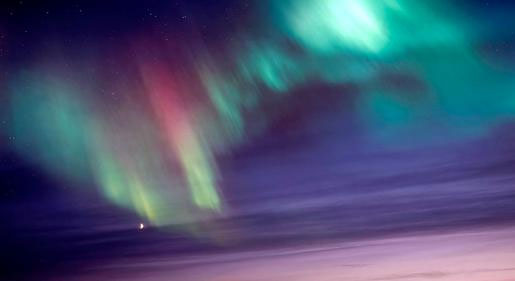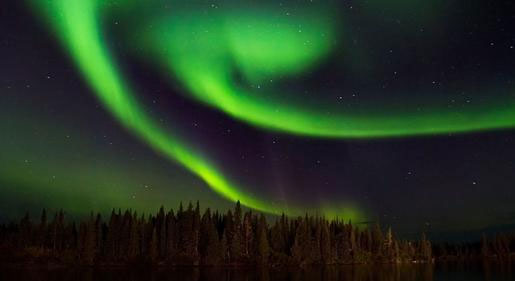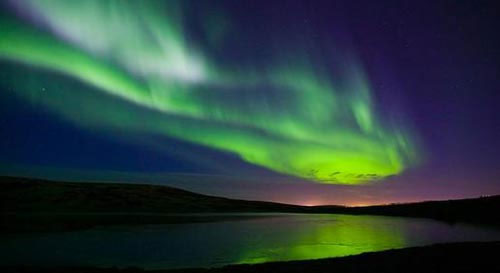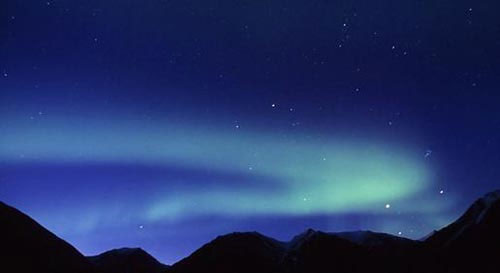Bright light of aurora
Aurora is an optical phenomenon characterized by bright bands of different shapes but moving and changing continuously, looking like silk strips in the sky.
>>>See the virtual aurora on the earth from the universe

Aurora is an optical phenomenon, characterized by the emergence of colorful light in the sky at night.This phenomenon produces bands of light that are constantly moving and changing.

The aurora that appears in the northern hemisphere of the Earth is called an aurora north, or arctic light, and is called aurora male when observed in the sky in the southern hemisphere.In the picture is the aurora phenomenon observed from ISS International Space Station on September 2.

In 1621, a French scientist named Pierre Gassendi saw the light from the north and named Aurora, after the name of a Greek god.The word "borealis" is named after the northern wind god Boreas.South aurora in the southern hemisphere is called aurora australis.Continuous light strips such as colored silk strips in the sky are actually born from millions of magnetic energy explosions.

The light of aurora is generated by the interaction between solar particles and the Earth's atmosphere.The energy from collisions creates particles of light and makes particles glow.

Aurora light appears most often between September and October, then is observed again in March and April. The aurora can sometimes appear in the winter.When the darkness envelops the sky, aurora light becomes brighter and can be seen longer.

For aurora research and evaluation, the US Aeronautics Agency (NASA) has built 20 terrestrial observatories in Alaska and Canada.Each research station is equipped with a digital camera with a fisheye lens, taking photos of the aurora every three seconds.The magnetometer is installed to record changes in the Earth's magnetic field.In the picture is a surface simulation covering the locations of observation stations.

The shape of aurora can change in many different forms, such as dim light lines, arcs, swirls or long tracks in the sky, changing and moving continuously.The phenomenon of aurora does not affect life on Earth, however, it may disrupt the supply of electricity and the transmission of communications by satellite or television and radio programs.

The more collisions in the sky occur in a high position, the stronger the color of aurora light.Most aurora occurs at a height of 100-900km above the Earth's surface.The most common color of aurora is blue, the case in the upper atmosphere will produce red and purple light.Gases in the atmosphere such as hydrogen, oxygen ., interacting with the solar particles, also play a role in the formation of aurora colors.

Aurora has brilliant green in the Alaska wilderness.

In magnetic storms resulting from the Sun's activity, the aurora can change from the polar region to the equator, because the Sun's eruption affects the Earth's magnetic field.When this happens, the observer can see the aurora north as in the picture.
- Aurora is on Christmas
- Aurora on Uranus
- STEVE - aurora appears for the first time with light purple
- Explanation of aurora phenomenon
- Northern light illuminates the UK
- Video: Red light pillar stands in the sky of Russia
- Virtual aurora phenomenon in Russia
- Video: Beautiful Northern Aurora from the universe
- See the virtual aurora on the earth from the universe
- The first aurora in the year
- The mysterious aurora was discovered on Saturn
- It is the first time to observe the aurora outside the Solar System
 The 11 most unique public toilets in the world
The 11 most unique public toilets in the world Explore the ghost town in Namibia
Explore the ghost town in Namibia Rare historical moments are 'colored', giving us a clearer view of the past
Rare historical moments are 'colored', giving us a clearer view of the past The world famous ghost ship
The world famous ghost ship Black aurora appears in the sky over Alaska
Black aurora appears in the sky over Alaska  Commercial aircraft reach supersonic speed
Commercial aircraft reach supersonic speed  25 most impressive Northern Lights photos of 2023
25 most impressive Northern Lights photos of 2023  Today, the sky is 'on fire' because a fireball collides with the Earth
Today, the sky is 'on fire' because a fireball collides with the Earth  Mysterious tomb of aliens
Mysterious tomb of aliens  Hi Steve, a beautiful new aurora phenomenon has just been discovered!
Hi Steve, a beautiful new aurora phenomenon has just been discovered! 